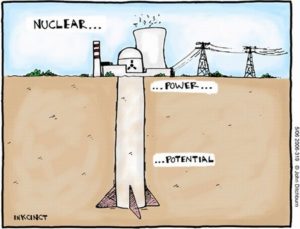I am, of course, borrowing from George H.W. Bush’s timeless declaration. But what’s really at issue here? There is no sense at all in building new nuclear capability in this country or, for that matter, any other.
In my classes on climate change and on clean tech, I identify nuclear power, along with carbon capture and storage (CCS) and geoengineering, as red herrings. By this I mean that these are wasteful technologies that only distract us from the urgent task of restructuring our consumption and production patterns to allow the planet to cool down. This definition, from a treatise on logic and debate, says “The term red herring is sometimes used loosely to refer to any kind of diversionary tactic, such as presenting relatively unimportant arguments that will use up the other debaters’ speaking time and distract them from more important issues.” That’s precisely what the debate on nuclear power does: uses up our time, not to mention our money and energy, and distracts us from infinitely more fruitful pursuits.
Here is a raft of reasons why we can’t afford new nukes and, in fact, nuclear power needs to be phased out:
First and foremost, it siphons money from our efforts on real clean tech: energy efficiency, renewables, green building, etc. Amory Lovins, in his paper “Four Nuclear Myths” says it succinctly and eloquently: “…expanding nuclear power…will reduce and retard climate protection. That’s because…new nuclear power is so costly and slow that …it will save about 2-20 times less carbon per dollar, and about 20-40 times less carbon per year, than investing instead in the market winners-efficient use of electricity and…’micropower,’ comprising distributed renewables…and cogenerating electricity together with useful heat in factories and buildings.” (I made the same argument to the Chairman of the United Kingdom Atomic Energy Authority a couple of years ago.)
 Danger: You might remember Three Mile Island and Chernobyl. You probably haven’t heard about the near-catastrophe at Davis-Besse in Ohio in early 2002. “Only a thin stainless steel veneer-less than one quarter-inch thick-had prevented a loss-of-coolant accident more serious than that at Three Mile Island in 1979. Had the corroded reactor vessel head ruptured, the loss of cooling water would likely have led to both a reactor meltdown and a containment failure.” (See p. 17 of this report from the Union of Concerned Scientists.) The longer the world’s 436 active nuclear power plants operate, the greater the chances of another Chernobyl happening. More reactors only up the danger.
Danger: You might remember Three Mile Island and Chernobyl. You probably haven’t heard about the near-catastrophe at Davis-Besse in Ohio in early 2002. “Only a thin stainless steel veneer-less than one quarter-inch thick-had prevented a loss-of-coolant accident more serious than that at Three Mile Island in 1979. Had the corroded reactor vessel head ruptured, the loss of cooling water would likely have led to both a reactor meltdown and a containment failure.” (See p. 17 of this report from the Union of Concerned Scientists.) The longer the world’s 436 active nuclear power plants operate, the greater the chances of another Chernobyl happening. More reactors only up the danger.
Waste Heat: Nuclear power only exists for central generating facilities powered by heat. Just as with coal or gas, nuclear fission heats water to produce steam which turns a turbine which turns a generator which produces electricity. Just about two-thirds of the energy that goes into producing the steam is lost as heat in these plants. Two-thirds! So nuclear power is incredibly inefficient.
Low Carbon? Not Really: One analyst, writing in Energy Policy recently, notes “…that nuclear power is not directly emitting greenhouse gas emissions, but rather that lifecycle emissions occur through plant construction, operation, uranium mining and milling, and plant decommissioning.” An article from Nature Reports Climate Change summarizes the findings thus: nuclear power is much less GHG-intensive than coal or gas, but much more than solar or wind – “…nuclear emits twice as much carbon as solar photovoltaic, at 32 gCO2e/kWh, and six times as much as onshore wind farms, at 10 gCO2e/kWh.”
Limitless Supplies of Fissionable Material? Not really: The Lean Guide to Nuclear Energy says “Shortages of uranium – and the lack of realistic alternatives – leading to interruptions in supply, can be expected to start in the middle years of the decade 2010-2019, and to deepen thereafter.”
(There’s much more to say, but I’m going to leave this for the moment and continue it over the course of the next several days. To tell you the truth, it’s gorgeous Spring weather outside and I need to get out there.)